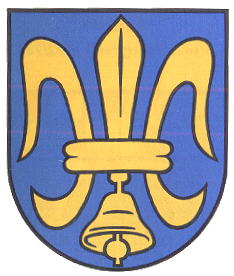Lochtum: Difference between revisions
Knorrepoes (talk | contribs) m (Text replacement - "/Arms of " to "/Arms (crest) of ") Tags: Mobile edit Mobile web edit |
Knorrepoes (talk | contribs) m (Text replacement - "{{media}}" to " {{de1}} {{media1}}") |
||
| Line 26: | Line 26: | ||
As a fleur-de-lis is not a very distinguishable symbol, the small bell was added. The bell represents the bell of the chapel of the estate of Adalbert I, Archbishop of Bremen in the village. Adalbert took refuge here in 1066. The chapel was destroyed in the 1930s, and the bell is one of the few remaining items from the chapel. | As a fleur-de-lis is not a very distinguishable symbol, the small bell was added. The bell represents the bell of the chapel of the estate of Adalbert I, Archbishop of Bremen in the village. Adalbert took refuge here in 1066. The chapel was destroyed in the 1930s, and the bell is one of the few remaining items from the chapel. | ||
{{ | |||
{{de1}} | |||
{{media1}} | |||
[[Civic Heraldry Literature - Germany|'''Literature''']]: Rabbow, 1977 | [[Civic Heraldry Literature - Germany|'''Literature''']]: Rabbow, 1977 | ||
Revision as of 11:28, 26 December 2022
This page is part of the German heraldry portal Deutsche Wappensammlung |
Heraldry of the World |
|
German heraldry:
|
Selected collector's items from Germany:
|
LOCHTUM
State : Niedersachsen
District (Kreis) : Goslar
Incorporated into : 1972 Vienenburg
| German | |
| English | No blazon/translation known. Please click here to send your (heraldic !) blazon or translation |
Origin/meaning
The arms were officially granted on August 6, 1965.
The arms show a unique symbol, a combination of a bell and a fleur-de-lis. The fleur-de-lis is derived from the arms of the seal of Heinrich von Lochtum on a document from 1397. The fleur-de-lis thus stands for the oldest known Lords of the village.
As a fleur-de-lis is not a very distinguishable symbol, the small bell was added. The bell represents the bell of the chapel of the estate of Adalbert I, Archbishop of Bremen in the village. Adalbert took refuge here in 1066. The chapel was destroyed in the 1930s, and the bell is one of the few remaining items from the chapel.
Literature: Rabbow, 1977


